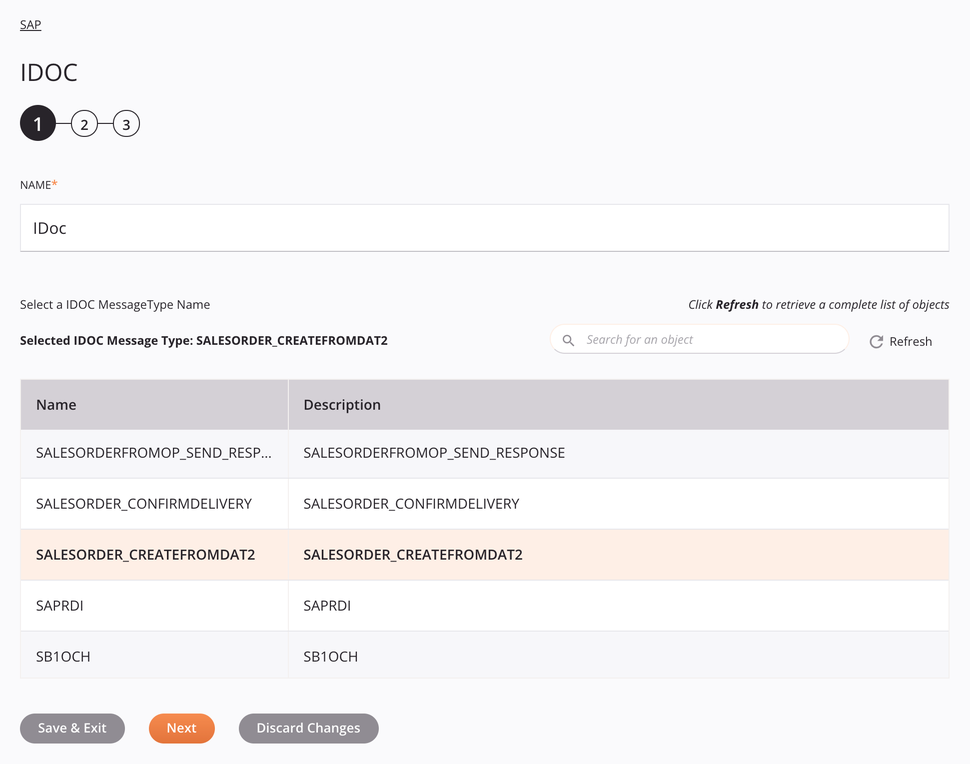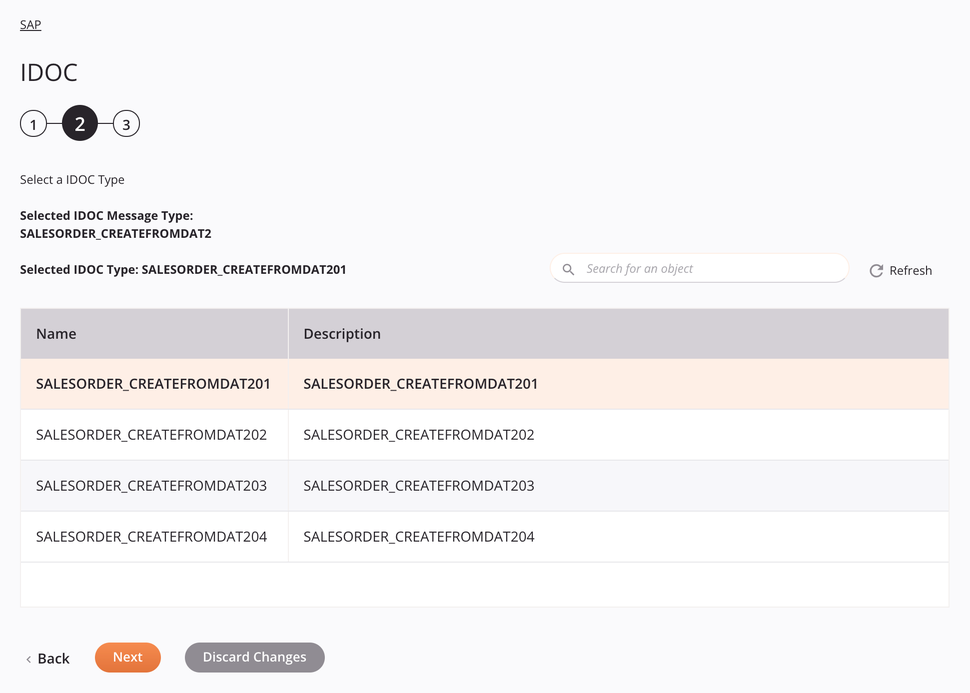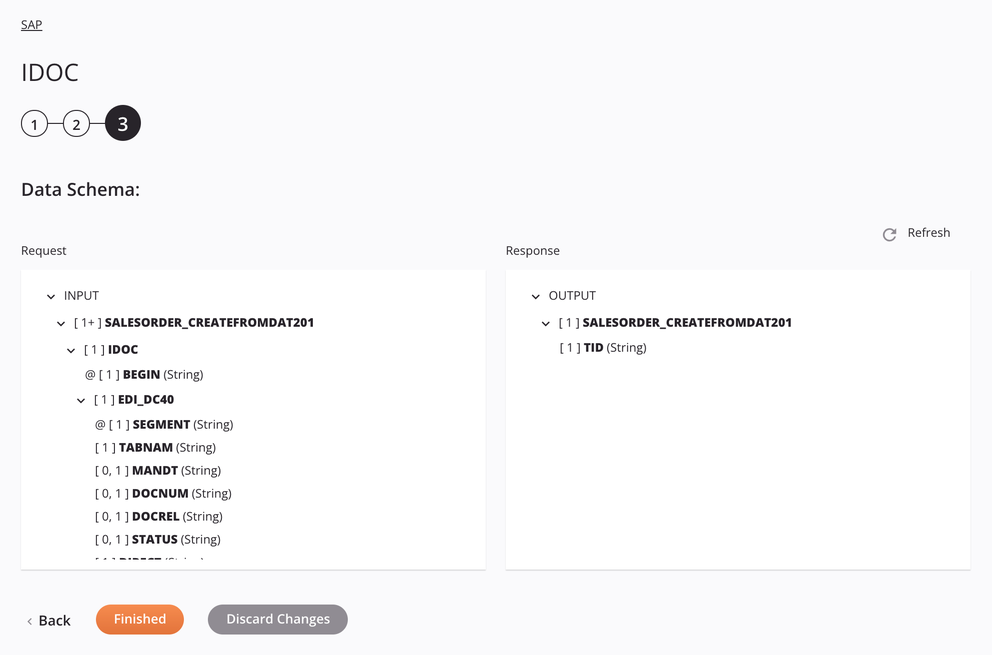SAP IDoc activity¶
Introduction¶
An SAP IDoc (Intermediate Document) activity is configured to use a specific IDoc. It can be used by an operation to send inbound IDocs (inbound to SAP, outbound from Jitterbit) to an SAP system. You can configure as many SAP IDoc activities as you like for each SAP connection.
Note
Outbound IDocs (outbound from SAP, inbound to Jitterbit) are not supported with the Cloud Studio SAP Connector. Outbound IDoc activities require the Jitterbit SAP event listener available for Design Studio.
Create an IDOc Sap activity¶
An instance of an activity is created from a connection using an activity type.
To create an instance of an activity, drag the activity type to the design canvas or copy the activity type and paste it on the design canvas. For details, see Creating an activity instance in Component reuse.
An existing activity can be edited from these locations:
- The design canvas (see Component actions menu in Design canvas).
- The project pane's Components tab (see Component actions menu in Project pane Components tab).
Accessing menu actions¶
Menu actions for an activity are accessible from the project pane and the design canvas. For details, see Activity actions menu in Connector basics.
Configure an SAP IDoc activity¶
Follow these steps to configure an SAP IDoc activity:
- Step 1: Enter basic information and select an IDoc message type
- Step 2: Select an IDoc type
- Step 3: Review data schema
Step 1: Enter basic information and select an IDoc message type¶

-
Name: Enter a name to use to identify the SAP IDoc activity. The name must be unique for each IDoc activity and must not contain forward slashes (
/) or colons (:). -
Select an IDoc Message Type Name: This section displays the IDoc message types available in the SAP endpoint. When reopening an existing activity configuration, only the selected IDoc message type is displayed instead of reloading the entire message type list.
- Selected IDoc Message Type: After a message type is selected, it will be listed here.
- Search: Enter any column's value into the search box to filter the list of message types. The search is not case-sensitive. If message types are already displayed within the table, the table results will be filtered in real time with each keystroke. To reload message types from the endpoint when searching, enter search criteria and then refresh.
- Refresh: Click the refresh icon
 or the word Refresh to reload message types from the SAP endpoint. This may be useful if you have recently added message types to the SAP instance. This action refreshes all metadata used to build the table of message types displayed in the configuration.
or the word Refresh to reload message types from the SAP endpoint. This may be useful if you have recently added message types to the SAP instance. This action refreshes all metadata used to build the table of message types displayed in the configuration. - Select an IDoc Message Type: Within the table, click anywhere on a row to select a message type. Only one message type can be selected. The information available for each message type is fetched from the SAP endpoint:
- Name: The IDoc message type name in SAP.
- Description: The IDoc message type description in SAP.
Tip
If the table does not populate with available message types, the SAP connection may not be successful. Ensure you are connected by reopening the connection and retesting the credentials.
-
Save & Exit: If enabled, click to save the configuration for this step and close the activity configuration.
-
Next: Click to temporarily store the configuration for this step and continue to the next step. The configuration will not be saved until you click the Finished button on the last step.
-
Discard Changes: After making changes, click Discard Changes to close the configuration without saving changes made to any step. A message will ask you to confirm that you want to discard changes.
Step 2: Select an IDoc type¶

-
Select an IDoc Type: This section displays IDoc types available for the selected IDoc message type in the SAP endpoint. When reopening an existing activity configuration, only the selected IDoc type is displayed instead of reloading the entire type list.
- Selected IDoc Message Type: The IDoc message type selected in the previous step will be listed first.
- Selected IDoc Type: After an IDoc type is selected, it will be listed here.
- Search: Enter any column's value into the search box to filter the list of types. The search is not case-sensitive. If types are already displayed within the table, the table results will be filtered in real time with each keystroke. To reload types from the endpoint when searching, enter search criteria and then refresh, as described below.
- Refresh: Click the refresh icon
 or the word Refresh to reload types from the SAP endpoint. This may be useful if you have recently added types to the SAP instance. This action refreshes all metadata used to build the table of types displayed in the configuration.
or the word Refresh to reload types from the SAP endpoint. This may be useful if you have recently added types to the SAP instance. This action refreshes all metadata used to build the table of types displayed in the configuration. - Select an IDoc Type: Within the table, click anywhere on a row to select a type. Only one type can be selected. The information available for each type is fetched from the SAP endpoint:
- Name: The IDoc type name from SAP.
- Description: The IDoc type description from SAP.
Tip
If the table does not populate with available types, the SAP connection may not be successful. Ensure you are connected by reopening the connection and retesting the credentials.
-
Next: Click to temporarily store the configuration for this step and continue to the next step. The configuration will not be saved until you click the Finished button on the last step.
-
Discard Changes: After making changes, click Discard Changes to close the configuration without saving changes made to any step. A message will ask you to confirm that you want to discard changes.
Step 3: Review data schema¶

-
Data Schema: The request and response data schemas for SAP will be displayed. If the operation uses a transformation, the data schemas will be displayed again later during the transformation mapping process, where you can map to target fields using source objects, scripts, variables, custom values, and more.
Refer to the SAP Help Portal and engage with your SAP administrator or SAP consultant for information on BAPI, RFC, and IDoc schema fields.
-
Refresh: Click the refresh icon
 or the word Refresh to regenerate schemas from the endpoint. This action also regenerates the schema in other locations throughout the project where the same schema is referenced, such as in an adjacent transformation.
or the word Refresh to regenerate schemas from the endpoint. This action also regenerates the schema in other locations throughout the project where the same schema is referenced, such as in an adjacent transformation. -
Back: Click to temporarily store the configuration for this step and return to the previous step.
-
Finished: Click to save the configuration for all steps and close the activity configuration.
-
Discard Changes: After making changes, click Discard Changes to close the configuration without saving changes made to any step. A message will ask you to confirm that you want to discard changes.
Next steps¶
After configuring an SAP IDoc activity, complete the configuration of the operation by adding and configuring other activities, transformations, or scripts as operation steps. You can also configure an operation's operation settings, which include the ability to chain operations together that are in the same or different workflows.
SAP IDoc activities can be used as a target with these operation patterns: - Transformation pattern - Two-transformation pattern (as the first or second target)
Operations that contain an SAP activity can only have one SAP activity and cannot also contain any NetSuite, Salesforce, Salesforce Service Cloud, ServiceMax, or SOAP activities. Note that there is currently a known issue where operations that contain more than one of these types of activities appear to be valid and are able to be deployed without error. However, the operation will fail at runtime.
Other patterns are not valid using SAP IDoc activities. See the validation rules on the Operation validity page.
To use the activity with scripting functions, write the data to a temporary location and then use that temporary location in the scripting function.
When ready, deploy and run the operation and validate behavior by checking the operation logs.